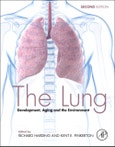The second edition of The Lung: Development, Aging and the Environment provides an understanding of the multi-faceted nature of lung development, aging, and how the environment influences these processes. As an essential resource to respiratory, pulmonary, and thoracic scientists and physicians it provides an interface between the "normal and "disease cluster of chapters, allowing for a natural complement to each other. The interface between different lung diseases affecting the pediatric lung also adds a useful source for comparing how different lung diseases share key pathophysiological features. This same complementarity comes across in the logical line up of chapters dealing with the "normal pediatric lung. New research, including cell-based strategies for infant lung function, epigenetics, and prenatal alcohol exposure on lung development and function are some of the important additions to this edition of this reference work.
Please Note: This is an On Demand product, delivery may take up to 11 working days after payment has been received.
Table of Contents
Chapter 1: Lung Progenitor Cell Specification and MorphogenesisChapter 2: Development of Airway Epithelium
Chapter 3: Development of the Innervation of the Lower Airways: Structure and Function
Chapter 4: The Formation of Pulmonary Alveoli
Chapter 5: Pulmonary Vascular Development
Chapter 6: Developmental Physiology of the Pulmary Circulation
Chapter 7: Development of Salt and Water Transport across Airway and Alveolar Epithelia
Chapter 8: Physical, Endocrine, and Growth Factors in Lung Development
Chapter 9: The Development of the Pulmonary Surfactant System
Chapter 10: Ontogeny of the Pulmonary Immune System
Chapter 11: Development of Antioxidant and Xenobiotic Metabolizing Enzyme Systems
Chapter 12: Stretch and Grow: Mechanical Forces in Compensatory Lung Growth
Chapter 13: Pulmonary Transition at Birth
Chapter 14: Normal Aging of the Lung
Chapter 15: Cell-Based Strategies for the Treatment of Injury to the Developing Lung
Chapter 16: Epigenetics and the Developmental Origins of Lung Disease
Chapter 17: Pulmonary Consequences of Preterm Birth
Chapter 18: The Effects of Neonatal Hyperoxia on Lung Development
Chapter 19: The Influence of Nutrition on Lung Development before and after Birth
Chapter 20: Genetic Factors Involved in Susceptibility to Lung Disease
Chapter 21: Effects of Environmental Tobacco Smoke during Early Life Stages
Chapter 22: Nicotine Exposure during Early Development: Effects on the Lung
Chapter 23: Exposure to Allergens during Development
Chapter 24: The Epidemiology of Air Pollution and Childhood Lung Diseases
Chapter 25: Environmental Toxicants and Lung Development in Experimental Models
Chapter 26: Effect of Environment and Aging on the Pulmonary Surfactant System
Chapter 27: Environmental Determinants of Lung Aging
Authors
Kent Pinkerton Professor of Pediatrics, School of Medicine, University of California, Davis, USA. Kent Pinkerton, MD, is professor of pediatrics, School of Medicine, and director of the Center for Health and the Environment at the University of California, Davis.His research focuses on the health effects of inhaled environmental air pollutants to alter respiratory, cardiovascular, and neurological structure and function. Special areas of interest include the interaction of gases and airborne particles to produce cellular and structural changes within site-specific regions and cells of the respiratory tract in both acute and chronic timeframes of exposure. Recent studies have focused on environmental and biological impacts of synthesized nanomaterials as well as the effects of environmental tobacco smoke and combustion particles on lung growth and development.
He is associate director for the San Joaquin Aerosol Health Effects Research Center (SAHERC) to study airborne particles of the San Joaquin Valley. He is also the associate director for the Western Center for Agricultural Health and Safety (WCAHS) to study the health effects of airborne particles in an agricultural setting. Richard Harding Emeritus Professor, Department of Anatomy and Developmental Biology, Monash University, Clayton, Australia. Richard Harding is a NHMRC Senior Principal Research Fellow and an Emeritus Professor with the Department of Anatomy and Developmental Biology at Monash University, Australia. His research focuses on Respiratory Development and Programming. He is now semi-retired.








